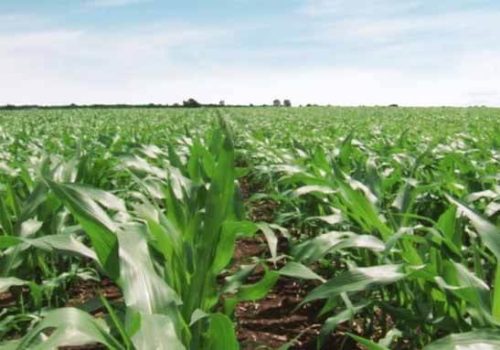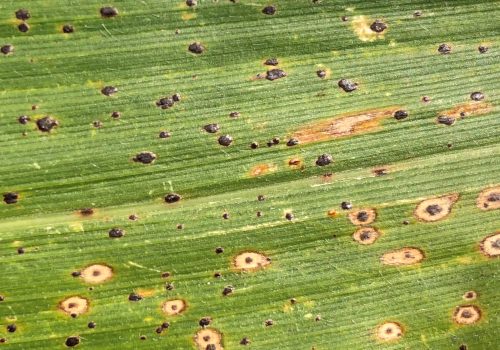Identifying Tar Spot in US Corn
Tar spot of corn is a relatively new disease to the U.S. It was first reported in northwest Indiana and north-central Illinois in 2015 by Kiersten Wise, Gail Ruhl and Tom Creswell from Purdue University. Since 2015, this disease has spread and can now be found in several states (Figure 1). Prior to 2015, tar spot only occurred in Mexico, Central America and northern parts of South America in cooler high elevation environments
Fungal Pathogen Responsible
Tar spot observed in the United States is caused by a fungus referred to as Phyllachora maydis.1 In Latin America where P. maydis was first observed, it has been known to form a complex with a secondary fungal pathogen, Monographella maydis. The combination of the two fungus are referred to as tar spot complex and known to cause more severe yield loss when both pathogens are present.2 In Latin America where M. maydis has been observed, it appears as a secondary “fisheye” shaped lesion surrounding the original P. Maydis tar spot. Although similar lesions surrounding the tar spot lesion have been observed in the U.S., to date M. Maydis has not been formally identified.1
Identification
- Tar spot can be identified by raised black, circular fungal structures (Figure 2 stromata) which appear as specks of tar splattered onto the leaf surface.
- Lesions have a bumpy feel that is not easily rubbed off.
- Spots can also be surrounded by a small, tan halo giving a “fish-eye” appearance.
- The disease begins on the lower corn leaves and moves to the upper plant and ear husks.
- Tar spot is found on both healthy and dead plant tissue on upper and lower surface of leaves.
- It can be confused with common and southern rust late in season as they switch from producing orange-red spores (urediniospores) to black spores (teliospores), but rust pustules differ in that they may easily be scraped from the leaf.
- Tar spot may also be confused with saprophytic organisms that break down dead plant tissue late in season, however they will not exhibit a bumpy texture.
- Laboratory diagnosis may be required to correctly diagnose the disease.
Development
Tar spot can take 14 to 40 days before symptoms appear after infection. It can move limited ranges by wind and plant residue. Current weather patterns have created a higher risk for widespread infection. It appears to be capable of overwintering in soil and residue due to its reoccurrence in years following its first introduction. This disease thrives in cool (60-70 F) and humid conditions with prolonged periods of wet leaves. Visual symptoms of tar spot generally start on the lower leaves and rapidly move up the plant. Infection can occur at any crop stage, although it is most commonly observed throughout the grain fill period.
Management Practices
Due to only recently being introduced to the United States, best management practices are still being developed. Employing multiple management practices are critical for dealing with tar spot.
- Hybrid Selection: Hybrids differ in susceptibility to tar spot infection, making hybrid selection one of the first tools for managing this disease. Hybrid differences observed in Table 1 can be used in hybrid placement decisions for fields with known history of tar spot.
- Crop Rotation and Tillage: Rotating to crops other than corn and utilizing tillage to bury residue could help reduce fungus inoculum levels in fields. Due to newness of tar spot, much is still unknown of the magnitude of the reduction that comes from increased residue management practices.
- Fungicide Application: Early fungicide applications at or before first signs of development have been effective at reducing tar spot in previous trials.3 Early fungicide programs applied prior to the onset of disease can be effective, however, infection often occurs weeks before symptoms, making timing of preventative fungicide applications challenging. Late season curative applications of fungicides are typically not affective and not recommended.
- If conditions are favorable for tar spot development early in the season, an application at V4-V8 corn growth stage and/or the VT/R1 growth stage with a registered product could reduce infection within fields previously confirmed with tar spot in prior years.
- Fully registered Syngenta fungicide options include Trivapro® and Miravis® Neo to manage tar spot.
- It is important to also consider other disease risks that may help justify an application for tar spot. Potential for other diseases like gray leaf spot, Northern corn leaf blight, Northern corn leaf spot and rust can help simplify decisions to treat fields with a broad spectrum fungicide that can manage multiple diseases simultaneously.
For more information on tar spot or for help with scouting and decision making, contact your local Golden Harvest Seed Advisor or agronomist.
Photos are either the property of Syngenta or used under agreement.
Syngenta hereby disclaims liability for third-party websites.
©2020 Syngenta. The trademarks or service marks displayed or otherwise used herein are the property of a Syngenta Group Company. All other trademarks are the property of their respective owners.



